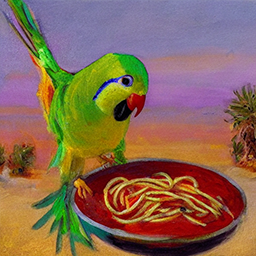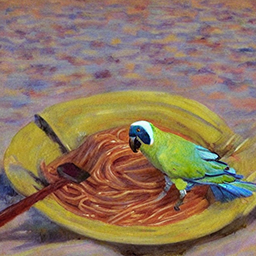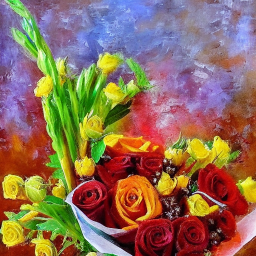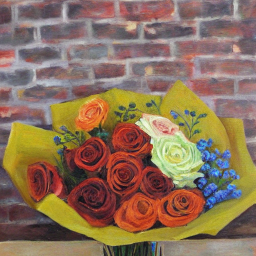https://github.com/fboulnois/stable-diffusion-docker
Run the official Stable Diffusion releases in a Docker container with txt2img, img2img, depth2img, pix2pix, upscale4x, and inpaint.
https://github.com/fboulnois/stable-diffusion-docker
dall-e dalle diffusion docker generative-art huggingface image-generation inpainting midjourney pytorch stable-diffusion tensorflow text-to-image
Last synced: 6 months ago
JSON representation
Run the official Stable Diffusion releases in a Docker container with txt2img, img2img, depth2img, pix2pix, upscale4x, and inpaint.
- Host: GitHub
- URL: https://github.com/fboulnois/stable-diffusion-docker
- Owner: fboulnois
- License: agpl-3.0
- Created: 2022-08-23T01:57:45.000Z (about 3 years ago)
- Default Branch: main
- Last Pushed: 2023-12-29T01:36:15.000Z (almost 2 years ago)
- Last Synced: 2025-04-04T05:08:38.591Z (6 months ago)
- Topics: dall-e, dalle, diffusion, docker, generative-art, huggingface, image-generation, inpainting, midjourney, pytorch, stable-diffusion, tensorflow, text-to-image
- Language: Python
- Homepage:
- Size: 666 KB
- Stars: 743
- Watchers: 9
- Forks: 131
- Open Issues: 8
-
Metadata Files:
- Readme: README.md
- Changelog: CHANGELOG.md
- Contributing: CONTRIBUTING.md
- License: LICENSE
Awesome Lists containing this project
- awesome-ai-painting - https://github.com/fboulnois/stable-diffusion-docker
README
# Stable Diffusion in Docker
Run the official [Stable Diffusion](https://huggingface.co/CompVis/stable-diffusion)
releases on [Huggingface](https://huggingface.co/) in a GPU accelerated Docker
container.
```sh
./build.sh run 'An impressionist painting of a parakeet eating spaghetti in the desert'
```


```sh
./build.sh run --image parakeet_eating_spaghetti.png --strength 0.6 'Bouquet of roses'
```


## Before you start
### Minimum requirements
By default, the pipeline uses the full model and weights which requires a CUDA
capable GPU with 8GB+ of VRAM. It should take a few seconds to create one image.
On less powerful GPUs you may need to modify some of the options; see the
[Examples](#examples) section for more details. If you lack a suitable GPU you
can set the options `--device cpu` and `--onnx` instead.
### Huggingface token
Since it uses the official model, you will need to create a [user access token](https://huggingface.co/docs/hub/security-tokens)
in your [Huggingface account](https://huggingface.co/settings/tokens). Save the
user access token in a file called `token.txt` and make sure it is available
when building the container. The token content should begin with `hf_...`
## Quickstart
The pipeline is managed using a single [`build.sh`](build.sh) script.
Pull the latest version of `stable-diffusion-docker` using `./build.sh pull`.
You will need to use the option `--token` to specify a valid [user access token](#huggingface-token)
when using [`./build run`](#run).
Alternately, build the image locally before running it.
## Build
Make sure your [user access token](#huggingface-token) is saved in a file called
`token.txt`.
To build:
```sh
./build.sh build # or just ./build.sh
```
## Run
### Text-to-Image (`txt2img`)
Create an image from a text prompt.
To run:
```sh
./build.sh run 'Andromeda galaxy in a bottle'
```
### Image-to-Image (`img2img`)
Create an image from an existing image and a text prompt.
First, copy an image to the `input` folder. Next, to run:
```sh
./build.sh run --image image.png 'Andromeda galaxy in a bottle'
```
### Depth-Guided Diffusion (`depth2img`)
Modify an existing image with its depth map and a text prompt.
First, copy an image to the `input` folder. Next, to run:
```sh
./build.sh run --model 'stabilityai/stable-diffusion-2-depth' \
--image image.png 'A detailed description of the objects to change'
```
### Instruct Pix2Pix (`pix2pix`)
Modify an existing image with a text prompt.
First, copy an image to the `input` folder. Next, to run:
```sh
./build.sh run --model 'timbrooks/instruct-pix2pix' \
--image image.png 'A detailed description of the objects to change'
```
### Stable UnCLIP Variations (`unclip`)
Create different versions of an image with a text prompt.
First, copy an image to the `input` folder. Next, to run:
```sh
./build.sh run --model 'stabilityai/stable-diffusion-2-1-unclip-small' \
--image image.png 'A detailed description of the image'
```
### Image Upscaling (`upscale4x`)
Create a high resolution image from an existing image with a text prompt.
First, copy an image to the `input` folder. Next, to run:
```sh
./build.sh run --model 'stabilityai/stable-diffusion-x4-upscaler' \
--image image.png 'Andromeda galaxy in a bottle'
```
### Diffusion Inpainting (`inpaint`)
Modify specific areas of an existing image with an image mask and a text prompt.
First, copy an image and an image mask to the `input` folder. White areas of the
mask will be diffused and black areas will be kept untouched. Next, to run:
```sh
./build.sh run --model 'runwayml/stable-diffusion-inpainting' \
--image image.png --mask mask.png 'Andromeda galaxy in a bottle'
```
## Options
The following are the most common options:
* `--prompt [PROMPT]`: the prompt to render into an image
* `--model [MODEL]`: the model used to render images (default is
`CompVis/stable-diffusion-v1-4`)
* `--height [HEIGHT]`: image height in pixels (default 512, must be divisible by 64)
* `--width [WIDTH]`: image width in pixels (default 512, must be divisible by 64)
* `--iters [ITERS]`: number of times to run pipeline (default 1)
* `--samples [SAMPLES]`: number of images to create per run (default 1)
* `--scale [SCALE]`: how closely the image should follow the prompt (default 7.5)
* `--scheduler [SCHEDULER]`: override the scheduler used to denoise the image
(default `None`)
* `--seed [SEED]`: RNG seed for repeatability (default is a random seed)
* `--steps [STEPS]`: number of sampling steps (default 50)
Other options:
* `--attention-slicing`: use less memory but decrease inference speed (default
is no attention slicing)
* `--device [DEVICE]`: the cpu or cuda device to use to render images (default
`cuda`)
* `--half`: use float16 tensors instead of float32 (default `float32`)
* `--image [IMAGE]`: the input image to use for image-to-image diffusion
(default `None`)
* `--image-scale [IMAGE_SCALE]`: how closely the image should follow the
original image (default `None`)
* `--mask [MASK]`: the input mask to use for diffusion inpainting (default
`None`)
* `--negative-prompt [NEGATIVE_PROMPT]`: the prompt to not render into an image
(default `None`)
* `--onnx`: use the onnx runtime for inference (default is off)
* `--skip`: skip safety checker (default is the safety checker is on)
* `--strength [STRENGTH]`: diffusion strength to apply to the input image
(default 0.75)
* `--token [TOKEN]`: specify a Huggingface user access token at the command line
instead of reading it from a file (default is a file)
* `--vae-slicing`: use less memory when creating large batches of images
(default is no vae slicing)
* `--vae-tiling`: use less memory when creating ultra-high resolution images but
massively decrease inference speed (default is no vae tiling)
* `--xformers-memory-efficient-attention`: use less memory but require the
xformers library (default is that xformers is not required)
Some of the original `txt2img.py` options [have been renamed](https://github.com/fboulnois/stable-diffusion-docker/issues/49)
for easy-of-use and compatibility with other pipelines:
| txt2img | stable-diffusion-docker |
|---------|-------------------------|
| `--H` | `--height` |
| `--W` | `--width` |
| `--n_iter` | `--iters` |
| `--n_samples` | `--samples` |
| `--ddim_steps` | `--steps` |
## Examples
These commands are both identical:
```sh
./build.sh run 'abstract art'
./build.sh run --prompt 'abstract art'
```
Set the seed to 42:
```sh
./build.sh run --seed 42 'abstract art'
```
Options can be combined:
```sh
./build.sh run --scale 7.0 --seed 42 'abstract art'
```
Many popular models are supported out-of-the-box:
| Model Name | Option using `--model` |
|------------|------------------------|
| [Stable Diffusion 1.4](https://huggingface.co/CompVis/stable-diffusion-v1-4) | `'CompVis/stable-diffusion-v1-4'` |
| [Stable Diffusion 1.5](https://huggingface.co/runwayml/stable-diffusion-v1-5) | `'runwayml/stable-diffusion-v1-5'` |
| [Stable Diffusion 2.0](https://huggingface.co/stabilityai/stable-diffusion-2) | `'stabilityai/stable-diffusion-2'` |
| [Stable Diffusion 2.1](https://huggingface.co/stabilityai/stable-diffusion-2-1) | `'stabilityai/stable-diffusion-2-1'` |
| [Stable Diffusion XL](https://huggingface.co/stabilityai/stable-diffusion-xl-base-1.0) | `'stabilityai/stable-diffusion-xl-base-1.0'` |
| [OpenJourney 1.0](https://huggingface.co/prompthero/openjourney) | `'prompthero/openjourney'` |
| [Dreamlike Diffusion 1.0](https://huggingface.co/dreamlike-art/dreamlike-diffusion-1.0) | `'dreamlike-art/dreamlike-diffusion-1.0'` |
| [and more!](https://huggingface.co/models?other=stable-diffusion&sort=likes) | ... |
```sh
./build.sh run --model 'prompthero/openjourney' --prompt 'abstract art'
```
On systems without enough GPU VRAM, you can try mixing and matching options:
* Give Docker Desktop more resources by increasing the CPU, memory, and swap in
the Settings -> Resources section if the container is terminated
* Make images smaller than 512x512 using `--height` and `--width` to decrease
memory use and increase image creation speed
* Use `--half` to decrease memory use but slightly decrease image quality
* Use `--attention-slicing` to decrease memory use but also decrease image
creation speed
* Use `--xformers-memory-efficient-attention` to decrease memory use if the
pipeline and the hardware supports the option
* Decrease the number of samples and increase the number of iterations with
`--samples` and `--iters` to decrease overall memory use
* Skip the safety checker with `--skip` to run less code
```sh
./build.sh run --height 256 --width 256 --half \
--attention-slicing --xformers-memory-efficient-attention \
--samples 1 --iters 1 --skip --prompt 'abstract art'
```
On Windows, if you aren't using WSL2 and instead use MSYS, MinGW, or Git Bash,
prefix your commands with `MSYS_NO_PATHCONV=1` (or export it beforehand):
```sh
MSYS_NO_PATHCONV=1 ./build.sh run --half --prompt 'abstract art'
```
## Outputs
### Model
The model and other files are cached in a volume called `huggingface`. The
models are stored in `/diffusers//snapshots//unet/`.
Checkpoint files (`ckpt`s) are unofficial versions of the official models, and
so these are not part of the official release.
### Images
The images are saved as PNGs in the `output` folder using the prompt text. The
`build.sh` script creates and mounts this folder as a volume in the container.
## Contributing
See the [CONTRIBUTING.md](CONTRIBUTING.md) file for more details. In short,
follow the style guidelines, agree to the Developer Certificate of Origin, and
submit a PR.